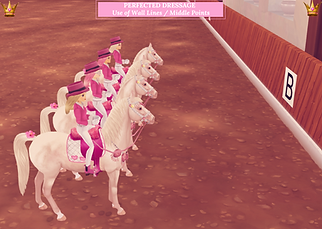
Kapitel 1
Merging & Splitting
Ulige rækkefølge
Leder: Odds (også kendt som 1'er) er altid den oprindelige linjeleder.
Bølge: For bølgebevægelser skal du altid gå til venstre, medmindre andet er angivet.
Tier linjer: Når du skærer på tier linjer, går odds til den yderligere tier line.
Tråd: Gå altid på 1. gang for trådbevægelser, medmindre andet er angivet.




1.

Anchors
Merging & Splitting
All merges and splits are performed using a specified sand line as the anchor for merging and splitting.
The riders will not base the split/merge off of the rider ahead, instead, they will base it off of the anchor point. When belting, merging, splitting, etc. all riders in line will merge/split/belt once their horse's nose has reached the anchor. When each rider uses the same anchor point, gaps, line order, alignment, and arena timing will not be negatively affected.
Riders will not adjust nor tap through merges and splits, instead, they will L-Corner onto the new sand line.
Once every rider in line has reached the anchor point, they will merge, split, or belt.
The photo demonstrates the wall line being an anchor point. The rider line has combed, once the rider's horse's nose reaches the wall line, they will merge towards the line leader.

Anchor Demo
In the video, the rider line demonstrates the wall line being an anchor for a belt. Once every rider in line reaches the wall line, they belt. They do not belt by simply following the person in front of them, instead they use the anchor.
After the belt, the riders have uniform and equal gaps as every rider belts at the exact same point: the anchor point.

Without an anchor point, merges and splits would negatively affect the rider line's gaps, alignment, timing, etc.
An important rule for splitting in merging is to never base the merge/split off of the rider ahead - instead, each rider will base the merge/split off of the specified marker. If a rider follows the rider ahead of them into a merge/split, they will most likely over-throw their sandline.
2.

Splitting
Splitting Methods
During splits, riders have specific methods to keep in mind to help ensure that the split is even, equal, and does not negatively affect gaps, arena timing, or alignments.
Line Order
When splitting, the riders need to be aware of their line order as their order in line will depict which direction they will split.
The order may vary depending on the type of split, but a general rule of thumb is to use anticipation: each rider will watch the rider second ahead of them - typically, what that rider does is what they will also do.

Gaps
Maintaining the correct gap size is important for the success of the split. If the rider line has uneven gaps, this will result in an uneven split. Before the split, each rider will check to make sure they are in the correct gap size.
After the split, the riders will assume Half Horse gaps unless specified otherwise (splitting from HI gaps places the riders into HH gaps).

Anchor Point
Each rider in line will split once they've reached the anchor point - a specified sand line or marker. This ensures that the split is even and equal and that arena timing is not affected.
If the rider line is splitting odds left evens right at X, each rider will L-Corner in their direction once their horse's nose has reached X.

Alignment
After the rider line splits, they will use a specified type of alignment (comb, tier, or staggered). Depending on the type of split will depend on the alignment needed.
If the rider line splits via waterfall, they will keep staggered alignment. If the rider line splits via tier, they will keep tier alignment.

Splitting Demo
In the video, the rider line demonstrates an odds left/evens right split at X. Each rider in the line splits once they've reached the anchor point (X). After splitting, the riders maintain half-horse gaps and use staggered alignment.


Merging
3.
Merging Methods
During merges, riders have specific methods to keep in mind to help ensure that the merge is even, equal, and does not negatively effect gaps or line order.
Line Order
When merging, the riders need to be aware of their line order as their order in line will depict who they should merge behind. If the riders merge blindly, this can result in confusion and incorrect line orders.
The order may vary depending on the type of merge, but a general rule of thumb is that the line order will merge back into original line order.

Gaps
Maintaining the correct gap size is important for the success of the merge. If the rider line has uneven gaps, this will result in an uneven merge and therefore could affect line order. Before the merge, each rider will check to make sure they are in the correct gap size.

Alignment
Similar to gaps, the riders need to make sure they are in proper alignment. If the riders are not in the correct alignment, the merge will not be successful.
For example, if the rider line is merging from a tier and the riders are not in proper tier alignment, the line order and gaps will be negatively affected.

Anchor Point
Each rider in line will merge once they've reached the anchor point - a specified sand line or marker. This ensures that the merge is even and equal.
If the rider line is merging from the comb onto the wall line, each rider will merge towards the line leader once their horse's nose has reached the wall line.

Merging Demo
In the video, the rider line demonstrates a merge from two split lines. The riders are in half-horse gaps and using staggered alignment. Each rider in line merges onto the specified sand line at the specified anchor point.




